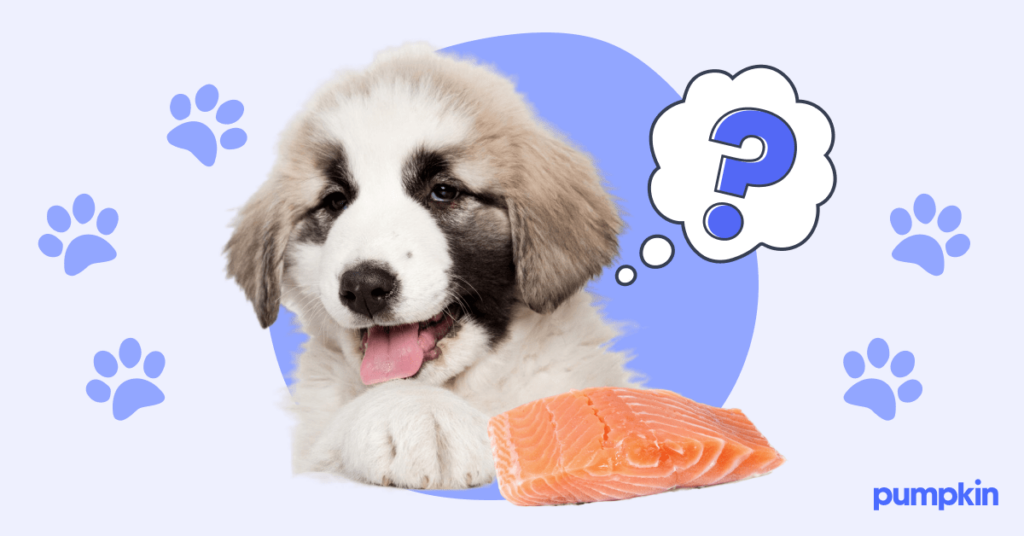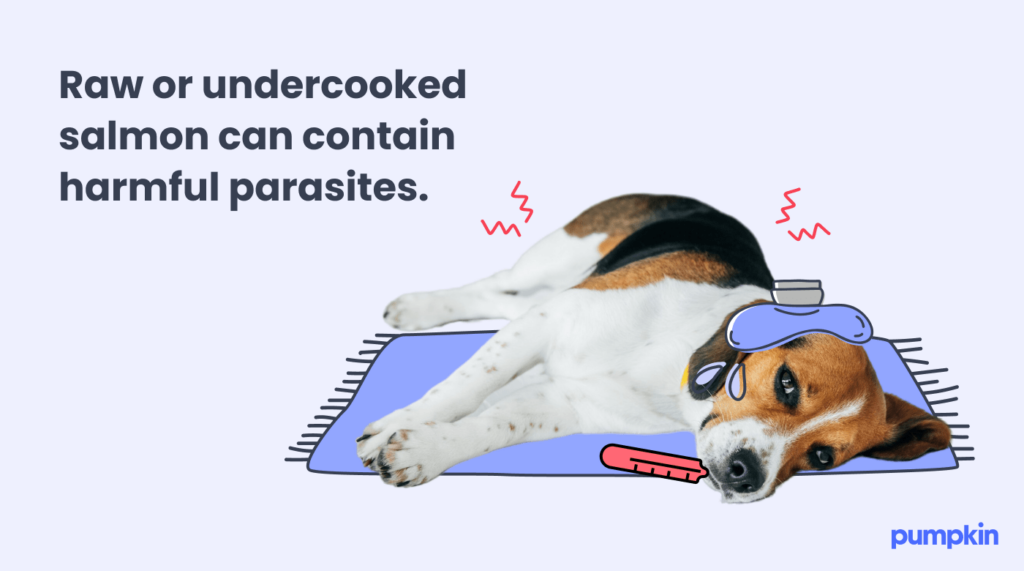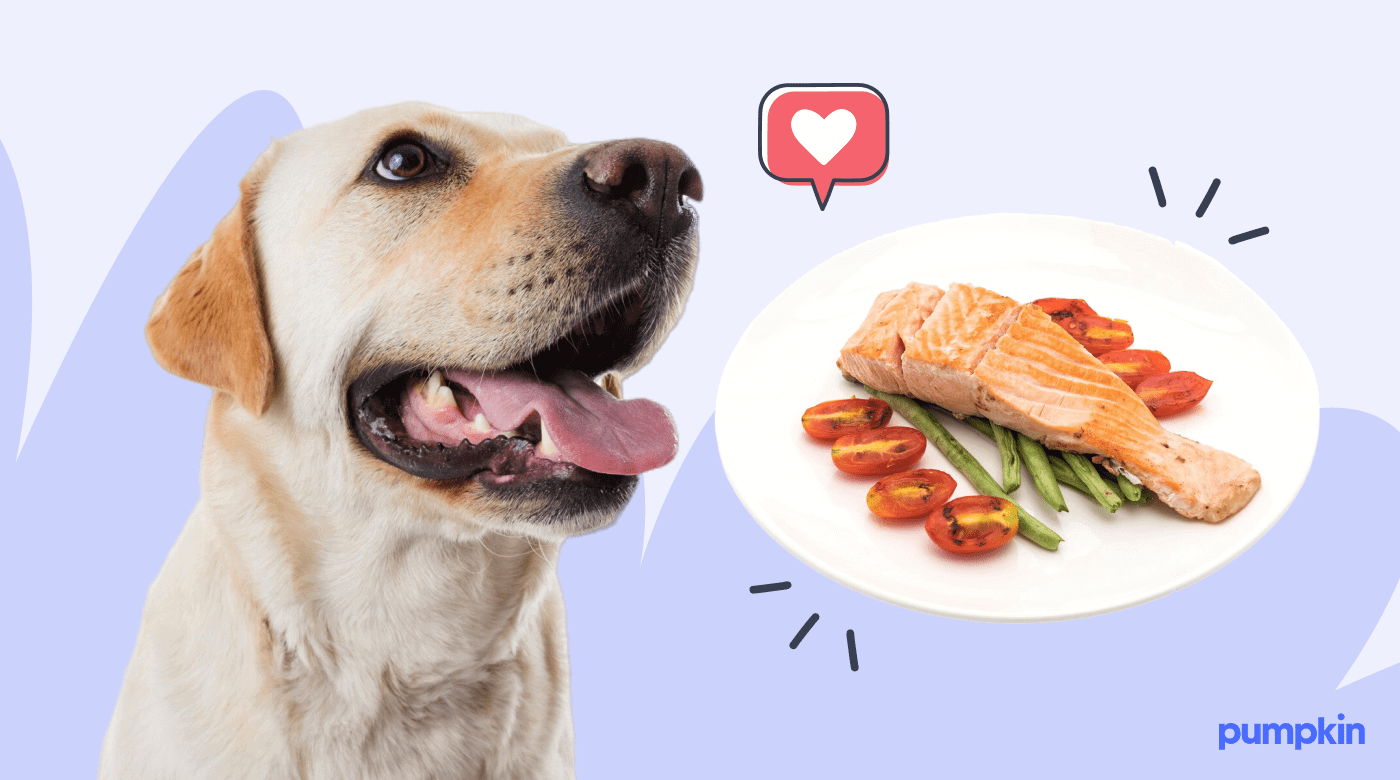Key Points
- Yes, dogs can eat salmon, but it should be cooked thoroughly to kill any potential parasites.
- Salmon is rich in omega-3 fatty acids and protein, which contribute to a healthy coat and strong muscles in dogs.
- Moderation is key when feeding salmon to dogs, so talk to your vet about how much to serve your pup.
If you have a tasty piece of salmon on your plate and your pup starts to whimper, you may be wondering if a bite or two will hurt.
For humans, salmon is packed with omega-3 fatty acids that are beneficial to the brain and heart, and protein that supports your muscles and bones. It’s a known superfood, so it makes sense you’d want to share it with your superdog.
So, can you give in to those big puppy dog eyes? Can dogs have salmon safely?
Dogs can eat salmon when it’s cooked properly. Rich in nutrients and protein, it’s a healthy, tasty treat.
Unfortunately, salmon may also be full of parasites and bacteria that can harm your hungry pup. If you’re planning to share a salmon snack, it’s your job to make sure it’s prepared right. So, let’s explore salmon’s nutritional and health benefits, serving sizes, and dog-safe preparation tips.
Dogs can have cooked salmon
Cooked salmon is a safe option for dogs to eat in moderation. It should be prepared and cooked thoroughly to kill any potential parasites. For pets, salmon should be served plain and free from any seasonings.
Salmon skin is also safe to eat, but some dogs may find it difficult to digest. Bones should always be removed because they can be a choking hazard, cause internal damage, and leave you with a hefty bill from the vet.
Is salmon safe for puppies?
Salmon is an excellent source of protein for growing pups. It’s safe for them to eat in moderation as long as it’s prepared correctly and they’re already eating solid food. For puppies and small dogs, salmon should be cooked thoroughly and chopped into small pieces.

When introducing new foods to your puppy, start with a small serving. Then, monitor them for signs of food intolerances or allergies.
Remember, puppies have unique dietary requirements and sensitive stomachs. Speak to your vet to learn about the best food for your pet.
The nutritional value of salmon for dogs
Salmon is a great source of omega-3 fatty acids, which can help support your dog’s immune system, reduce inflammation, and keep their coat shiny. Omega-3 is also good for their skin and joints. Some pet owners even use omega-3 to fight doggy dandruff.
This fish is also rich in protein, which is an essential nutrient for dogs of all ages. Protein gives the body amino acids that support muscle development, skin health, the immune system, and more.
The nutritional benefits for dogs don’t end there. Salmon also contains:
- Folic acid
- Vitamin B12
- Vitamin D
- Vitamin C
- Iron
- Magnesium
To glean the benefits from salmon, your dog doesn’t need a lot. Besides, too much may have a negative effect and give your dog an upset stomach.
The risks of feeding salmon to dogs
While salmon can be a healthy treat for dogs, it’s important to be aware of the potential risks.
If your dog eats too much of this fish, they may experience digestive issues. Some pups have seafood allergies, and munching on salmon may lead to itchy skin and an upset stomach.

Avoid feeding raw salmon to your dog. That means no matter how curious your pup is about your salmon roll, you should keep sushi off the menu. Raw or undercooked salmon can contain pesky parasites, such as Neorickettsia helminthoeca, which can cause salmon poisoning disease, a canine condition that can be fatal if left untreated.
Common signs of salmon poisoning include:
- Lack of appetite
- Vomiting or diarrhea
- Blood in stool
- Fever
- Muscle weakness
- Increased heart rate
- Difficulty breathing
- Muscle spasms or seizures
- Weight loss
Salmon poisoning is a serious condition. If you notice any of the above symptoms, call your vet. This type of infection requires immediate treatment.
How to prepare salmon for pups
Avoid adding any seasonings or extra oils (using a little olive oil while cooking is okay), as they can be harmful to dogs. Always purchase boneless salmon or remove any bones before serving.
Here are three ways you can safely cook salmon for dogs:
- Steam: Steamed salmon is a good option for both dogs and their pet parents. It will take around 12 minutes to cook in a steamer basket.
- Grill: Use a light spray of oil and grill the salmon on medium heat. It will take around five minutes on each side.
- Bake: Pop salmon in the oven for approximately 15 to 20 minutes at 350 degrees Fahrenheit.
No matter which method you choose, the salmon fillet should be cut into small pieces and left to cool before serving. You can offer your dog the salmon as a reward, mixed with vegetables, or as a healthy addition to their main meal.
And if you don’t feel like cooking, salmon can also be found in some commercial dog foods.
How much salmon can dogs eat?
The right serving size will depend on your dog’s weight and size, but here’s a general guide to get you started:
- Extra-small dogs: 1-2 ounces of cooked salmon
- Small dogs: 2-3 ounces of cooked salmon
- Medium dogs: 3-4 ounces of cooked salmon
- Large dogs: 4-6 ounces of cooked salmon
- Extra large dogs: 6-8 ounces of cooked salmon
Finally, most experts say that you shouldn’t serve salmon to your dog more than once per week. While commercial dog foods with salmon are a safe daily meal, homemade salmon should be an occasional treat.
Salmon alternatives for dogs
Dogs can eat other types of fish and seafood. Just like salmon, any fish on the dinner or treat menu should be cooked thoroughly and served in moderation. Avoid feeding your dog raw fish due to the risk of parasites and bacteria.
Here are some of our favorite salmon alternatives for dogs:
Tuna
If your dog likes the taste of tuna, it’s safe to eat in small portions. With omega-3 fatty acids, the “chicken of the sea” is good for their skin, fur, and eyes. Keep in mind that tuna contains mercury, which can lead to mercury poisoning in large doses.
Mackerel
Mackeral is another option rich in omega-3, vitamin D, and vitamin B12. In moderation, the “tiger of the sea” can fight inflammation and support bone growth. Avoid mackerel in brine or saltwater; it should also be free from seasonings, such as onion and garlic.
Trout
Most dogs can eat small servings of cooked trout without any issues. Trout is a rich source of protein for keeping those muscles and bones strong. It also contains omega-3 fatty acids, vitamin D, and potassium. Always remove the bones because they can be a choking hazard. And make sure the fish is thoroughly cooked to avoid any harmful bacteria.
Sardines
Sardines are a pup-friendly treat with omega-3 fatty acids, protein, vitamin B12, and more. These little fish are good for your dog’s immunity, skin, bones, and brain functioning. A few sardines added to your dog’s kibble can be irresistible.
Sardines can be a choking hazard for small dogs and pups, so consider chopping them first. Tinned varieties in oil can be fattening (make sure they’re also salt-free), so don’t overdo it.
Is smoked salmon safe for dogs?
Smoked salmon is not recommended for pets. It’s often high in salt, which can be harmful to your dog.
In the worst-case scenario, sodium poisoning may occur, which can lead to minor to severe side effects. Additionally, the smoking process doesn’t kill parasites as effectively as cooking, which raises the risk of salmon poisoning.
Can dogs eat wild-caught salmon?
Not only can dogs eat wild-caught salmon, but many people believe it’s better health-wise compared to farm-raised fish.
Bottom line: Is salmon good for dogs?
Feeding your dog salmon can be a healthy choice when it’s prepared correctly. It’s rich in omega-3 fatty acids and protein, which can contribute to a healthy coat and strong muscles.
However, salmon should be cooked thoroughly to kill any potential parasites and bacteria. Portion control is also important due to the high fat content of this fish. Always consult with your veterinarian before introducing new foods into your dog’s diet.
Even when you’re cautious, dogs can still have accidents and unexpected illnesses. If your pup eats too much salmon or sneaks some uncooked fish from the counter, an expensive visit to the vet may be in the cards. It’s a good idea to look into pet insurance if you haven’t already. It could help cover the costs of eligible care if your dog gets sick or hurt in the future, giving you one less thing to worry about.
Can dogs eat salmon? More FAQs
- https://pubmed.ncbi.nlm.nih.gov/20044285/
- https://www.health.harvard.edu/blog/finding-omega-3-fats-in-fish-farmed-versus-wild-201512238909
- https://vcahospitals.com/know-your-pet/salmon-poisoning
- https://recipes.net/articles/how-to-cook-salmon-for-dogs/
- https://www.petmd.com/dog/nutrition/can-dogs-eat-salmon
- https://health.clevelandclinic.org/fish-faceoff-wild-salmon-vs-farmed-salmon




